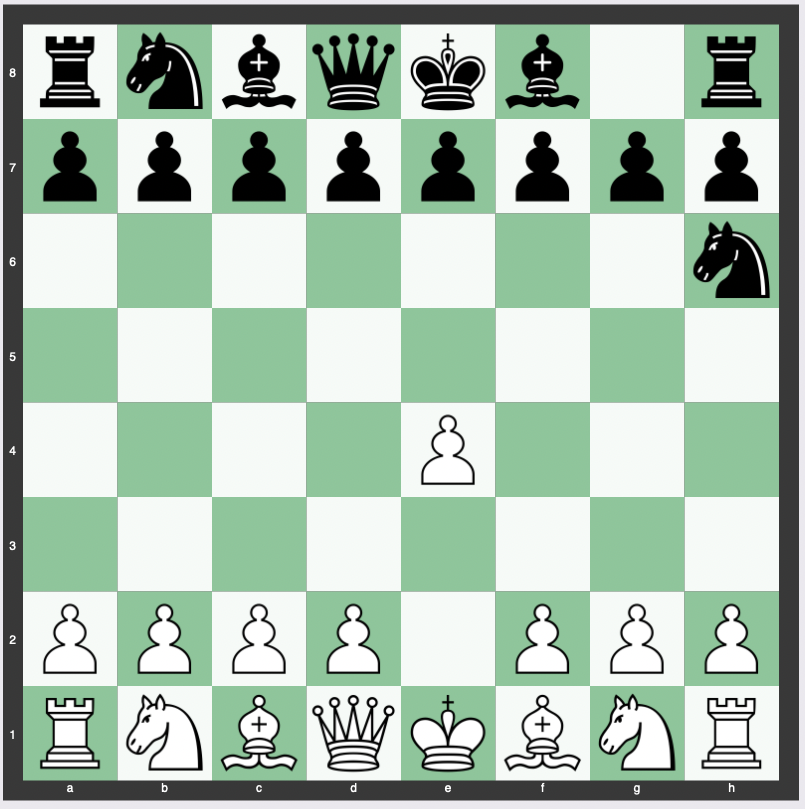The Adams Defense, also known as the Wild Bull Defense, is an unconventional and rare chess opening that deviates from traditional chess principles (e.g., center control, developing the knight to the inside of the board).
The opening starts with 1. e4 Nh6, which can lead to unique positions and challenges conventional opening principles.
Here we look into the specifics of this opening, providing insights into its move order, theory, variations, history, and usability for different skill levels, along with its prevalence at the grandmaster level.
Move Order of the Adams Defense (Wild Bull Defense)
The move order of the Adams Defense begins with White playing 1. e4, a common opening move that controls the center of the board.
Black’s response is 1…Nh6, a surprising move that places the knight on the edge of the board, a spot considered by many to be a suboptimal location for the piece.

This sequence sets the stage for the following play, often leading into unexplored territory.
Theory, Strategy and Purpose of the Adams Defense (Wild Bull Defense)
The theory behind the Adams Defense is unconventional.
By playing 1…Nh6, Black is choosing an offbeat path, often catching opponents off guard.
The strategy behind this move can be to lead the game into less well-known territories, where an opponent’s memorized lines and patterns are less likely to apply.
The purpose of this opening may vary, but it often aims at psychological warfare, tempting the opponent to overreach or become confused.
Variations of the Adams Defense (Wild Bull Defense)
There are several variations that can follow the initial 1. e4 Nh6, depending on White’s responses.
For example, 2. d4 leads to a more traditional game structure, while 2. Bc4 may challenge Black’s knight directly.
Different variations can lead to a wide array of positions, some more favorable to Black than others.
History of the Adams Defense (Wild Bull Defense)
The Adams Defense is named after Weaver Adams, an American chess master who advocated this opening.
Although rarely seen in top-level play, the opening has been around for decades.
It has been a subject of curiosity and sometimes ridicule due to its defiance of conventional chess wisdom.
Is the Adams Defense Good for Beginners or Intermediates?
The Adams Defense is not commonly recommended for beginners, as it violates several fundamental principles such as developing pieces towards the center.
Intermediate players may find value in it as a surprise weapon, but it requires a deep understanding of the resulting positions and the ability to adapt to unconventional play.
Studying this opening can also deepen one’s appreciation for the richness and flexibility of chess strategy.
How Often Is the Adams Defense (Wild Bull Defense) Played at the Grandmaster Level?
The Adams Defense is rarely seen at the grandmaster level.
Top players usually prefer openings that adhere to classical principles and have been extensively analyzed and tested.
However, it may occasionally appear in blitz or rapid games where the element of surprise is more valuable.
Chess Openings: Learn NOT to Play the Wild Bull Defense!
Conclusion
The Adams Defense, or Wild Bull Defense, represents a unique and rarely traveled path in the vast landscape of chess openings.
Its unconventional nature can provide opportunities for surprise and creative play but also brings inherent risks and challenges.
While it may not be suitable for every player, especially at the beginner level, it serves as a fascinating testament to the endless possibilities and diversity found within the game of chess.
Understanding this opening enriches our appreciation for the flexibility and depth that chess offers, even when venturing into the less-trodden paths.


